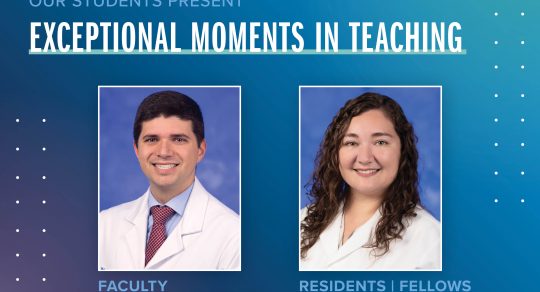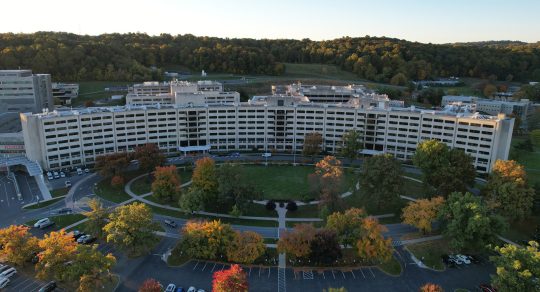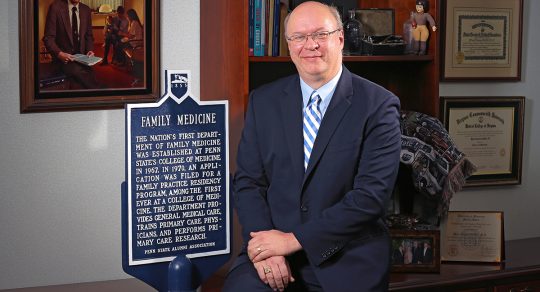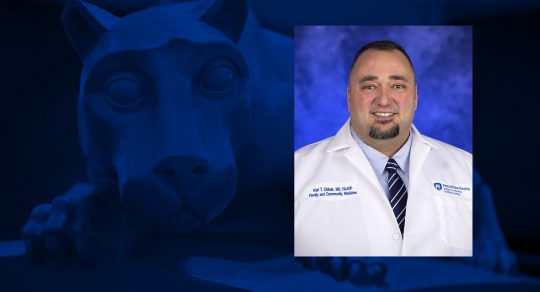Residency
Family and Community Medicine (State College)
The Penn State Health Family and Community Medicine Residency at Mount Nittany Medical Center in State College, Pa., is a three-year, ACGME-accredited program that admits six residents per year.
On This Page
The Penn State Health Family and Community Medicine Residency at Mount Nittany Medical Center gives residents the chance to make a difference in the lives of patients. Program faculty, staff and community physicians provide ample opportunities for continuing medical education to ensure optimal patient care and professional development.
Resident involvement in inpatient, outpatient and community activities is not only essential for the program’s growth but also sets you up for future success. Residents will have the opportunity to spend time in key specialties and subspecialties as well as participate in educational programs, prevention events and health screenings.
By partnering with Mount Nittany Health, the program has combined the resources of central Pennsylvania’s most trusted health care provider with the excellence of Penn State Health Milton S. Hershey Medical Center. This expands the ability to meet the growing need for family medicine physicians and provide superior care to Centre County residents.
The program’s goal is to prepare family physicians who are committed to the total health care of the individual and family. With only six slots per year, residents receive more individualized attention, a hallmark of the College of Medicine’s University Park experience.
As part of the only residency program in State College, residents in this program benefit from the academic support and resources of Penn State Health, Mount Nittany Health and Penn State University. By integrating standards of excellence with an innovative curriculum, the program prepares family physicians to practice quality, full-spectrum medicine.
This program, offered through the first department of Family and Community Medicine in an academic health center in the United States, is proud to provide a complete, sensitive and compassionate training opportunity for family physicians. Faculty and staff are committed to excellence and continuous improvement of education and patient care.

Program Highlights
Part of the distinguished Penn State family
Access to educational resources from Penn State University, Penn State Health Milton S. Hershey Medical Center, Penn State Health Medical Group — State College and Mount Nittany Health
Fellowship opportunities in sports medicine in State College, Pa., or Hershey, Pa.
Why Choose Family and Community Medicine?
Learn More about the Residency
General Application Guidelines
All applicants must apply through the Electronic Residency Application Service (ERAS).
Applicants will only be considered for interview and entry into the program if they meet the basic eligibility criteria below and have submitted a complete ERAS application.
Preference will be given to those applicants with solid academic standing at an LCME or AOA-accredited medical school and with a record of leadership, teamwork, compassion, and integrity.
Applicants are discouraged from making solicitations to the program via telephone call or through means other than ERAS.
.
Eligibility Criteria for Graduates of LCME–Accredited Allopathic U.S. Medical Schools
Graduated from medical school within the past three years. Preference is given to current academic year graduates.
Passed USMLE (Steps 1 and 2) with no more than one total prior failure.
Passed the Clinical Skills (CS) exam on first attempt.
Three letters of recommendation, including at least one from a family physician.
Eligibility Criteria for Osteopathic Graduates
Graduated from medical school within the past three years.
Graduates of colleges of osteopathic medicine in the United States accredited by the American Osteopathic Association (AOA).
COMLEX scores passed with no more than one total prior failure.
Three letters of recommendation, including at least one from a family physician.
Eligibility Criteria for Graduates of Non-LCME and AOA-Accredited Medical Schools
Very highly qualified graduates of non-LCME-accredited medical schools may possibly be considered for an interview if they meet the residency's standards for consideration.
Graduated from medical school within the past three years.
Passed USMLE (Steps 1 and 2) with no more than one total prior failure.
Passed the Clinical Skills (CS) exam on first attempt.
Minimum of three months clinical training in the United States, or clinical experience elsewhere which clearly demonstrates an understanding and interest in primary care and family medicine in particular.
Three letters of recommendation, including at least one from a family physician or primary-care physician.
Application to the Osteopathic Track
All physicians applying for an osteopathic-focused position are subject to the requirements as set forth in the ACGME Osteopathic Recognition Requirements, Section IV, "Residency Eligibility." Interested candidates must have sufficient background and/or instruction in osteopathic philosophy and techniques in manipulative medicine. Candidates for the osteopathic medicine track can hold a DO or MD degree.
Selection and Interview Process
The program begins reviewing candidates when ERAS opens in September. Once a completed ERAS application is received, qualified applicants will be invited for an interview until all available interview spots have been filled.
Applications are reviewed via ERAS beginning in September. Interviews are by invitation only and are scheduled October through January. A sample interview day itinerary appears below. The program pays for one night of hotel accommodations at a local hotel, although interviewees are responsible for providing their own transportation to State College. The program will also arrange for candidates to meet with current residents the evening prior to the interview.
Sample Interview Day Itinerary
Night before: Penn State Berkey Creamery with residents
7 a.m. Overview with the program coordinator
7:15 a.m. Breakfast with Penn State Health faculty and staff
8 a.m. Program director's welcome
8:45 a.m. Tour of practice site and Mount Nittany Medical Center
9:30 a.m. Interview 1
10 a.m. Interview 2
10:30 a.m. Break
10:45 a.m. Interview 3
11:15 a.m. Interview 4
11:45 a.m. Lunch with Mount Nittany Health faculty and staff
1:30 p.m. Questions and wrap-up with faculty
2:30 p.m. Closing
Schedules are subject to change.
For details, questions and/or comments, email statecollegefcmresidency@pennstatehealth.psu.edu.
Life in State College, Pa. ("Happy Valley")
State College, Pa., offers world-class residencies and fellowships in a university town setting.
Trainees can enhance both their careers and their quality of life in State College, home of Penn State University, the University Park Curriculum of Penn State College of Medicine, and Mount Nittany Health. The Centre County region is a unique area where cosmopolitan cultural influences blend with an affordable cost of living and relaxed country pace — all against a backdrop of lush, rural landscapes. It’s a place where both careers and families thrive.
Maybe that is what attracts a diverse spectrum of people from around the world: medical experts and college professors, artists and grade-school teachers, business executives and students.
No matter whether they are seeking collaboration with accomplished colleagues, inspiration from world-class entertainment, the charm and security of historic neighborhoods or the thrill of Big Ten sports events, residents find all that and more in State College.
Each trainee is at the center of an internationally recognized university town, working in a collegial atmosphere where patient care, careers and quality of life are all advancing. The region offers something for everyone, from the energetic, youthful vibe of downtown State College to the historic architecture and relaxed pace of nearby Bellefonte.
The moderate cost of living and affordable home prices create several housing choices, from a new home in a new neighborhood to a historic Victorian home or an easy-care condominium. Excellent public schools and a low crime rate make the area great for raising a family.
Centre County Statistics
Population: 160,580
Median household income: $50,295
Median home value: $193,500
Median rent: $872
Average commute to work: 20 minutes
Source: United States Census Bureau (2010–2015)
Learn more about the community
Program Benefits
Leadership


Program Coordinator, Family and Community Medicine Residency (State College, Pa.), Family and Community Medicine

Administrative Associate, Family and Community Medicine Residency (State College, Pa.), Family and Community Medicine
Supporting Your Training
Curriculum Details
Mission Statement
The program's mission is to provide the best possible family medicine graduate medical educational experience by teaching and demonstrating how to provide compassionate, coordinated, high-quality, evidence-based, cost-effective care in a safe learning environment that openly seeks to learn from and reduce medical errors while modeling lifelong learning.
Core Values
Educate to be the best.
Treat everyone with love and respect.
Foster true teamwork through servant-leadership and collaboration.
Promote passion for curiosity, continuous quality improvement and innovation.
Have integrity, honesty and transparency.
Promote health and well-being throughout the program.
Overall Educational Goals
Train fully competent and compassionate family physicians who are prepared to provide high-quality, coordinated, comprehensive and continuous primary care to families and the community.
Teach and demonstrate evidence-based, cost-effective care in a safe learning environment that openly seeks to learn from and reduce medical errors.
Train physicians to work in the context of a collaborative team.
Develop the physician into a lifelong learner and educator.
Train physicians to assume leadership roles in local communities, Pennsylvania and the nation.
Provide the people of central Pennsylvania compassionate, quality care regardless of their resources.
Research has shown that educational structure influences learner performance and well-being. Many residencies structure their schedule in traditional four- to eight-week block rotations. Some challenges of this model include reduced continuity with faculty and patients, interruptions to residents' skill development and a reduction in patient-centered care.
To address these challenges, this program takes a modified LIC approach by structuring rotations into one- to two-week experiences that repeat throughout the year. Residents receive a total of four to eight weeks in each core rotation, just like in the traditional approach. Current literature maintains that, in the following areas, LIC approaches have the following impacts.
Faculty/Resident Teaching Relationships
Facilitate the development of mentor relationships through continuity of feedback
Improve the faculty and learners precepting experience
Aid faculty’s ability to appropriately entrust levels of resident responsibility for patient care, coordination and education of other learners
Resident/Patient Clinical Relationships
Increase resident/patient continuity in an inpatient setting
Increase awareness of the way social context impacts patient care
Amplify medical learners patient-centeredness
Improve residents understanding of the patient’s illness experience
Residents' Intrapersonal Attributes and Professionalism
Maintain acquisition and retention of knowledge
Develop knowledge of personal strengths and weaknesses
Increase awareness of how a health care system functions
Provide a sense of preparation for practice in an ambulatory setting
Stem ethical erosion of learners
Improve understanding of health care coordination and the role of Family Medicine providers in the health care system
The LIC model is a validated educational structure that the program believes in strongly. Residents will have the opportunity to learn new skills, receive feedback and then revisit the rotation several weeks later with a refreshed perspective and skill set to build on previous learning. Most importantly, the LIC approach mirrors the wide spectrum of practice that residents will encounter in their careers as family physicians.
References
Mitchell M, Srinivasan M, West D, et al. Factors affecting resident performance: Development of a theoretical model and a focused literature review. Acad Med. 2005;80:376-389.
Hudson JN, Knight PJ, Weston KM. Patient perceptions of innovative longitudinal integrated clerkships based in regional, rural and remote primary care: A qualitative study. BMC Fam Pract. 2012;13:72.
Hirsh D, Gaufberg E, Ogur B, et al. Educational Outcomes of the Harvard Medical School-Cambridge Integrated Clerkship: A Way Forward for Medical Education. Acad. Med. 2012;87:643-650.
Mihalynuk T, Bates J, Page G, Fraser J. Student learning experiences in a longitudinal clerkship programme. Med Ed. 2008;42:729-732
Hauer KE, Hirsh D, Ma I, et al. The role of role: learning in longitudinal integrated and traditional block clerkships. Medical Education. 2012;46:698-710.
Hirsh DA, Holmboe ES, ten Cate O. Time to Trust: Longitudinal Integrated Clerkships and Entrustable Professional Activities. Academic Medicine. 2014;89:201-204.
Listed here is a sample schedule for Year 1 through Year 3. In each year, additional longitudinal and elective experiences are built in to enhance learning experiences and showcase the various specialties available in the region.
Please Note: Curriculum is subject to change as the program arranges the optimum educational experiences for residents. Individual resident schedules will vary.
Year 1
First-year curriculum is designed to provide interns with a diverse foundational base of family medicine topics to progressively build upon both in the inpatient and outpatient settings. First-year residents spend one half day per week seeing continuity patients in the Penn State Health - Park Avenue practice site.
Anticipated core rotations include:
Cardiology — four weeks
Emergency Medicine — four weeks
Family Medicine Inpatient — eight weeks
General Surgery — four weeks
Obstetrics — eight weeks
Pediatrics — eight weeks
Year 2
Second-year residents spend an average of four half-days per week in their continuity clinic and one half-day per month seeing continuity long-term care patients. Second-year curriculum is structured to continue to advance residents' competency and autonomy. Anticipated core rotations include:
Emergency Medicine — four weeks
Gynecology — four weeks
Hospitalist — eight weeks
ICU — eight weeks
Musculoskeletal — four weeks
Night Float — four weeks
Pediatrics — four weeks
Year 3
In the third and final year, residents spend time concentrating on areas of interest and preparing for graduation into independent practice. Third-year residents spend an average of five half-days per week in their continuity clinic and one half-day per month seeing continuity long-term care patients.
Anticipated core rotations include:
Emergency Medicine — four weeks
Family Medicine Inpatient - Senior — eight weeks
Musculoskeletal — four weeks
Night Float — four weeks
Elective options will be based on academic year and consent of the program director and/or coordinator. Options include:
Critical Care
Nephrology
Dermatology
Ophthalmology
Ears-Nose-Throat
Rehab
Endocrinology
Rheumatology
Global Health
Sports Medicine
Hematology/Oncology
Women's Health
Osteopathic-Focused Education
Residents in the osteopathic track receive an integrated osteopathic education and training experience to develop the knowledge, skills, and behavior necessary for successful osteopathic practice. Osteopathic principles and practice are integrated into the curriculum through lectures, hands-on workshops, direct patient care and an OMT skills evaluation at the beginning of each resident year. Training opportunities and resources are available from osteopathic family physicians within Penn State Health, Mount Nittany Health, and an affiliation with Philadelphia College of Osteopathic Medicine.
Osteopathic-focused residents will:
Perform an accurate and complete osteopathic structural examination to diagnose somatic dysfunction.
Incorporate osteopathic principles when obtaining a history, performing an examination, interpreting diagnostic testing, developing a differential diagnosis and devising a patient care plan.
Apply knowledge of the four tenets and osteopathic five-model concept in treating the patients.
Coordinate the health care team in providing compassionate, patient-centered care utilizing the osteopathic tenets.
Gain an understanding of the following with respect to OMT:
cost benefit and cost avoidance;
interaction of OMT within the health care system;
familiarity with principles of reimbursement, accurate coding and billing for OMT; and
assessing barriers that lead to disparities in health and health care
This series, presented as an hour-long conference, is mandatory for all family medicine residents. Presenters include osteopathic-focused faculty and osteopathic-track residents mentored by osteopathic-focused faculty.
Topics include:
Identification and Treatment of Cervical Spine Dysfunction
Identification and Treatment of Thoracic Spine Dysfunction
Identification and Treatment of Lumbar Spine Dysfunction
Identification and Treatment of Upper Extremity Dysfunction
Identification and Treatment of Lower Extremity Dysfunction
Treatment of Cardiovascular and Pulmonary Disorders Using Osteopathic Techniques
Treatment of Gastrointestinal Disorders Using Osteopathic Techniques
Osteopathic Treatment in Pregnancy
Treating the Headache with OMT
Advanced Techniques: HVLA
Advanced Techniques: Soft Tissue Techniques, Muscle Energy and FPR
This series, presented as a four-hour semiannual seminar, is mandatory for all family medicine residents and open to all medical staff for AOA credit through Mount Nittany Medical Center and an agreement with Philadelphia College of Osteopathic Medicine.
Presenters include osteopathic-focused faculty and osteopathic-tract residents mentored by osteopathic-focused faculty. While the seminars will include a didactic portion, greater time is devoted to hands-on demonstration and practice.
Topics include:
Treatment of cervical, thoracic and lumbar dysfunction
Treatment of upper and lower extremity dysfunction
Opportunities for osteopathic treatment of the hospitalized patient
Advanced techniques: HVLA, soft-tissue techniques, muscle energy and FPR
This committee meets quarterly to review inpatient cases and clinic cases utilizing osteopathic techniques.
The committee consists of Drs. Franklin Berkey, Ryan Ridenour, Kristen Grine and Philip Miller, and the meeting is mandatory for all osteopathic-track residents and open to all osteopathic physicians.
AOA credit through Mount Nittany Medical Center and an agreement with Philadelphia College of Osteopathic Medicine is available.
Resident Honors and Recognitions
The annual Resident/Fellow Research Day is held each year (with exception of during the COVID-19 pandemic) on and around the Penn State Health Milton S. Hershey Medical Center campus.
The intent of the event is to provide an opportunity for residents and fellows to showcase their research accomplishments to their peers in other clinical departments, as well as their colleagues in the basic sciences.
Learn more about Resident/Fellow Research Day here.
Previous presentations from the Family and Community Medicine Residency (State College, Pa.) are listed here.
Contact Information
Mailing Address
Penn State Health
Family and Community Medicine Residency at Mount Nittany Medical Center
143 Hospital Drive, Suite 207
State College, PA 16803
General Contact Information
Phone: 814-689-6789
Email: statecollegefcmresidency@pennstatehealth.psu.edu



